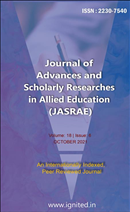Physico-Chemical Characteristics, Species Diversity and Density of Zooplankton
Exploring the Importance of Zooplankton in Aquatic Environments
Keywords:
zooplankton, physico-chemical characteristics, species diversity, density, aquatic environmentsAbstract
Zooplankton is tiny, free-floating creatures that are essential to aquatic environments' foodwebs. The zooplankton community responds strongly to changes in temperature, pH, dissolved oxygen,and nutrition levels in their environment. There are about 8,000 species of zooplankton that have beendescribed so far. This includes everything from copepods and rotifers to cladocerans and krill.Temperature, nutrition levels, and predation are only a few of the elements that might affect the speciesdiversity of zooplankton. The density of zooplankton fluctuates greatly with both latitude and season,with populations peaking in the warmer months of spring and summer when food and temperatureconditions are optimal. As zooplankton play a crucial part in the food chain and are an important foodsupply for many fish and other aquatic creatures, it is crucial to understand their physico-chemicalproperties, species diversity, and density to effectively monitor and manage aquatic ecosystems.Published
2021-10-01
How to Cite
[1]
“Physico-Chemical Characteristics, Species Diversity and Density of Zooplankton: Exploring the Importance of Zooplankton in Aquatic Environments”, JASRAE, vol. 18, no. 6, pp. 441–445, Oct. 2021, Accessed: Jul. 02, 2024. [Online]. Available: https://ignited.in/jasrae/article/view/13582
Issue
Section
Articles
How to Cite
[1]
“Physico-Chemical Characteristics, Species Diversity and Density of Zooplankton: Exploring the Importance of Zooplankton in Aquatic Environments”, JASRAE, vol. 18, no. 6, pp. 441–445, Oct. 2021, Accessed: Jul. 02, 2024. [Online]. Available: https://ignited.in/jasrae/article/view/13582








